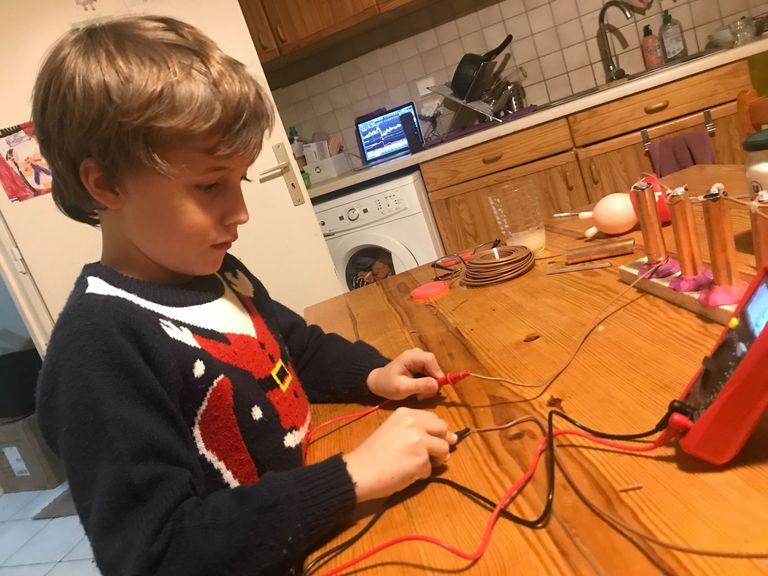
Two weeks ago I claimed that free energy can be created using earth batteries (a combination of copper, zinc & soil) and in this post I am going to back up my claim with evidence.
My goal with this experiment is twofold.
Firstly I am going to demonstrate how your voltage can be increased endlessly using earth batteries and secondly I am going to power this Peppa Pig night light which needs 4.5volts.

It did have x3 1.5v batteries (small round ones) but these are dead.

And this will I suspect become the first ever Peppa Pig to be powered by an earth battery!
What is free energy?
Before we begin I want first to address the definition of free energy, which seems to be a block for some people. To do this let's look at the materials I am using for this project.
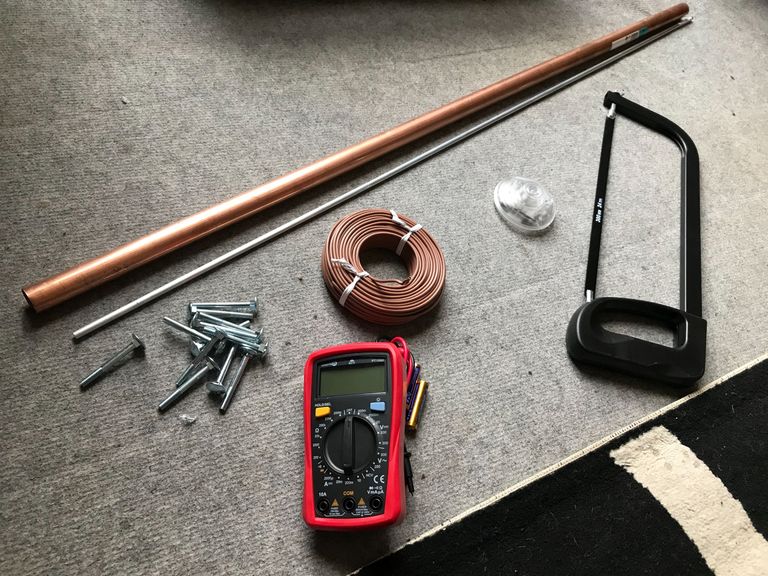
1m copper tube (22mm diameter)
1m aluminium rod (5mm diameter)
x12 zinc plated steel bolts
metal saw
25m electrical cable
Interrupter (on/off switch)
Multimeter
Needless to say these items used up a fair bit of energy on their journey from the earth to their current form on my floor. But when combined in a certain way, what they make is a machine that produces a non-stop electrical current. It doesn't need fuel (other than a little water) and it doesn't run out. So, in this situation a point will always be reached beyond which the energy being produced by the machine exceeds the energy used to create it. And at this point we can (in my opinion) call it free energy.
If someone has a better way to define free energy I would love to hear it!
The Earth Battery
For a more detailed breakdown of what is an earth battery please refer to my free energy post. But what we are basically talking about here is a copper cathode and an aluminium or zinc anode between which a flow of electrons is created in a moist solution of dirt or water.
In my energy post I showed you a cool guy I respect and his earth battery experiment on YouTube in which he was able to collect around 0.3v per cell using little strips of metal pushed into the earth in his garden.
After reading further it became evident that when we increase the surface area of the cathode & anode we also increase our voltage (up to a certain point). And so, I bought a copper tube (to act as the cathode) and an aluminium rod (to act as the anode).

When the anode is placed inside the cathode and there is a medium present (like damp soil or water) the electrons should move in all directions outward from the anode to the cathode, giving us our electrical current.
I also bought these steel bots as they are zinc plated and I was interested to make a comparison between the effectiveness of zinc & aluminium.

Getting started now I cut a 10cm piece of copper & aluminium.
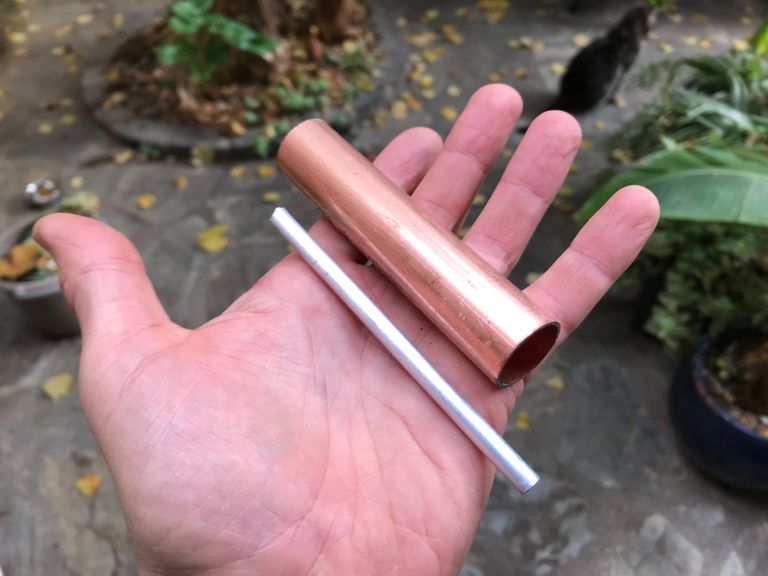
While my eventual goal is to set this up in the garden with permanent soldered components, all enclosed in a box of some kind to keep it safe, for now I am experimenting on the kitchen table, just to see what kind of results I can get here in this much warmer location. (Important note: my readings will be higher when it is in the ground because here on the kitchen table I am not able to capture the flow of telluric earth currents)
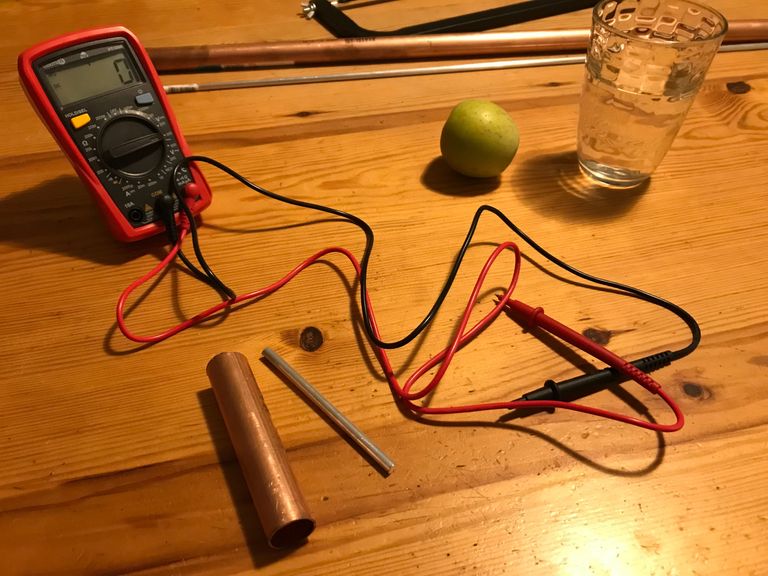
Rather than fill my 'cell' with damp soil straight away I wanted first to try the experiment with water. Sabrina is a qualified electrician and I have been reviewing her French study manuals in which I can see numerous experiments using water as a conductive medium.
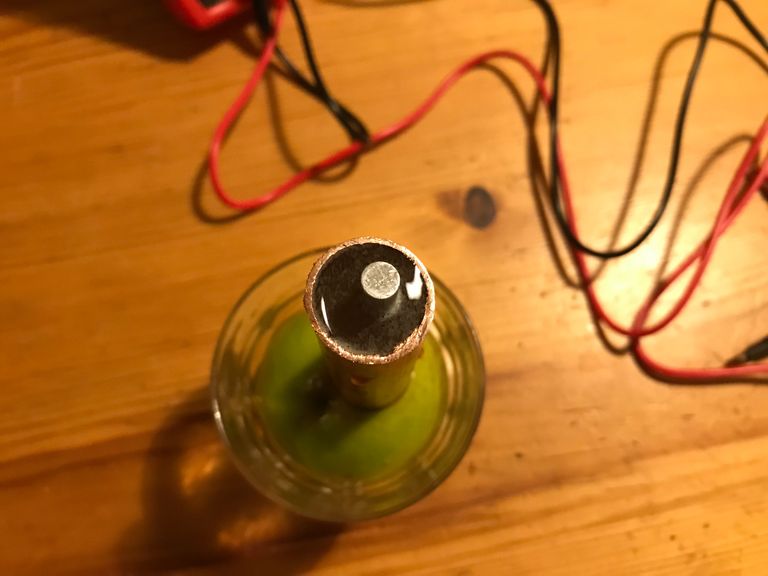
Straight away the voltmeter was picking up a reading of 0.5v, as you can see.
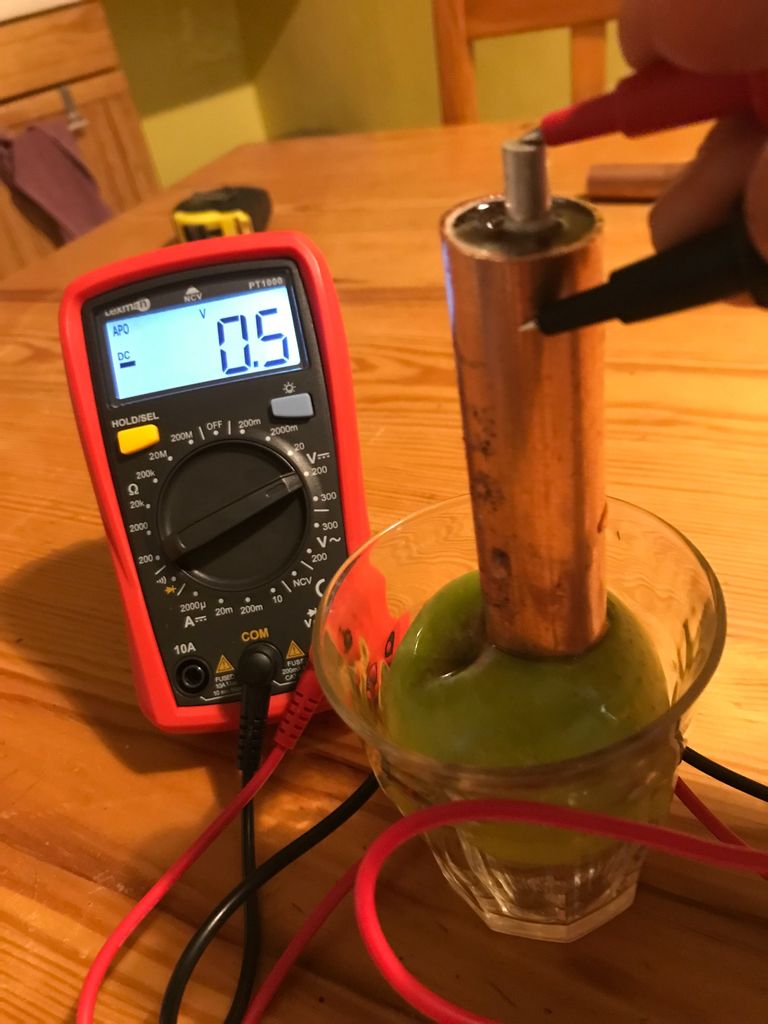
Wanting now to make a comparison with the zinc plated bolts I attached two together like this (making it 10cms).
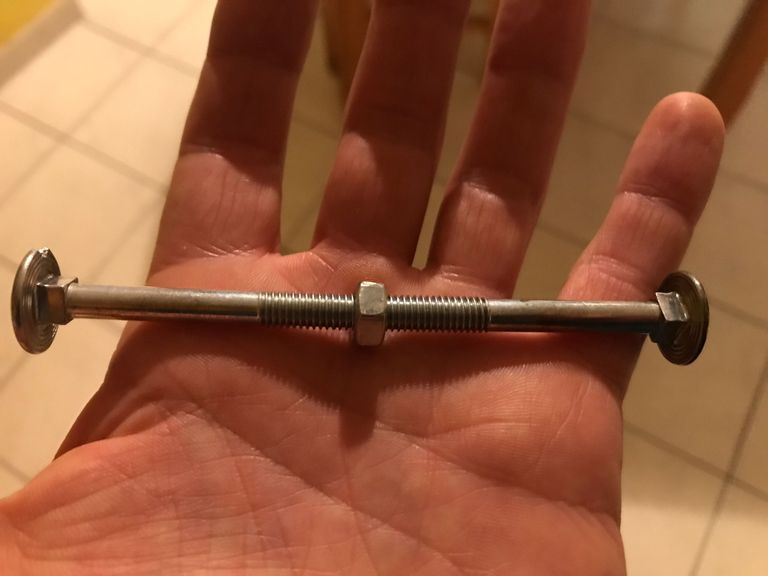
And repeated the experiment with water. Now I am getting 0.9v which is good to see.

The amperage was coming in at 0.8A. Remember this number as I will be coming back to it later.
The aluminium was put to one side knowing the zinc was more effective and I began to create a row of cells, wired in series.
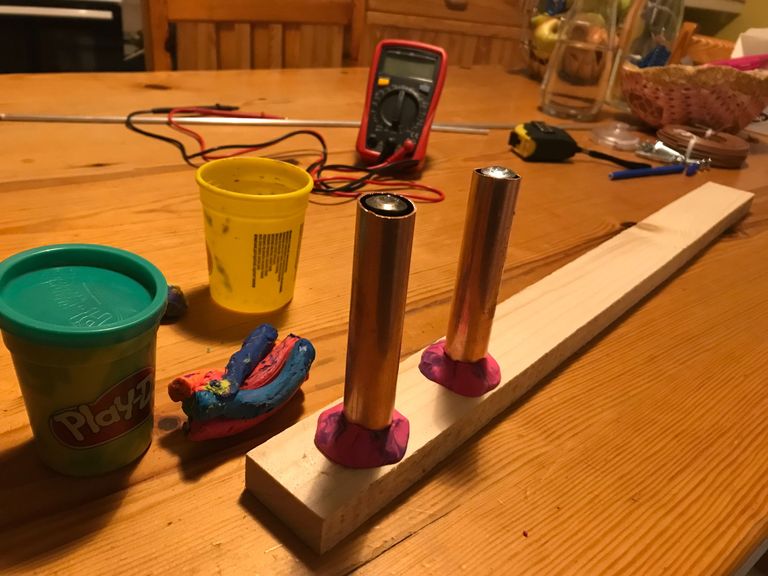
It turns out I don't have any solder to go with my soldering iron so I am using a glue gun instead which is far from ideal, but just about working for the purposes of this demonstration.
A connection is made between the copper cathode of one cell and the zinc anode of the other. I was hoping to see 1.8v (2x 0.9v) but I appear to be losing energy somewhere. Regardless, what this shows us is that the voltage output is increasing with the number of cells.
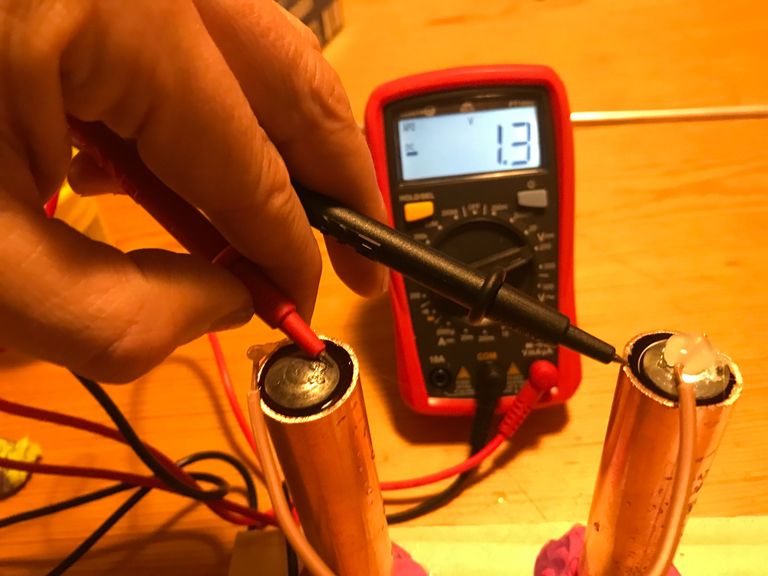
And so the experiment continues (right through Luna's tea time!) with a total of six cells.
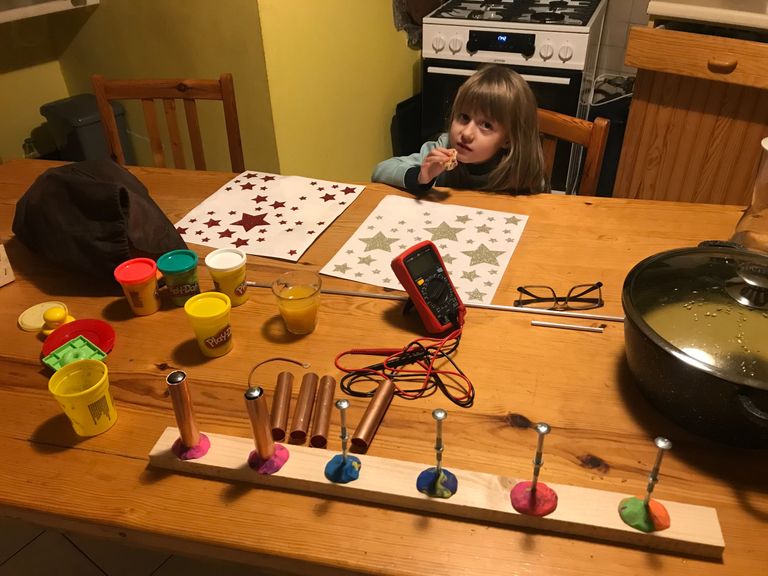
It was extremely hard to make the connections solid with the glue gun and after a while the water started to leak out of the play-doh bases but I was able to get a reading of 3.1v from these four cells. Again proving that output increases with number of cells.
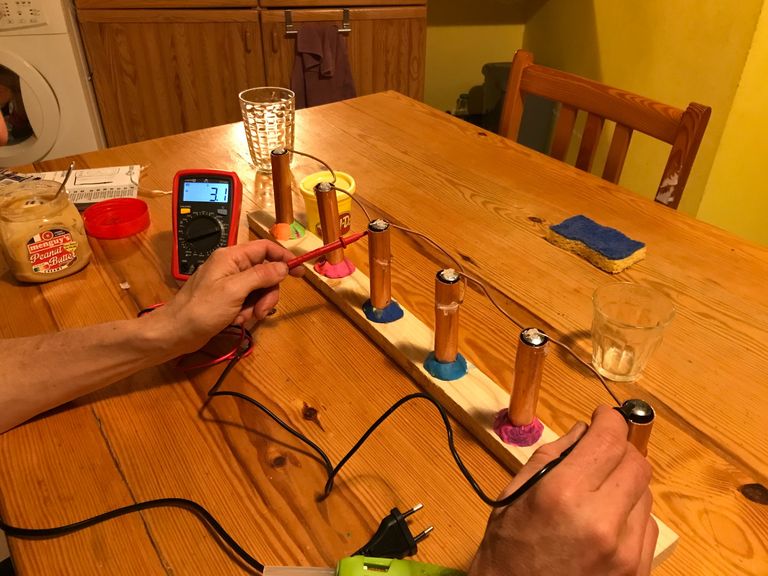
The following day I decided to have a go at using damp earth instead.
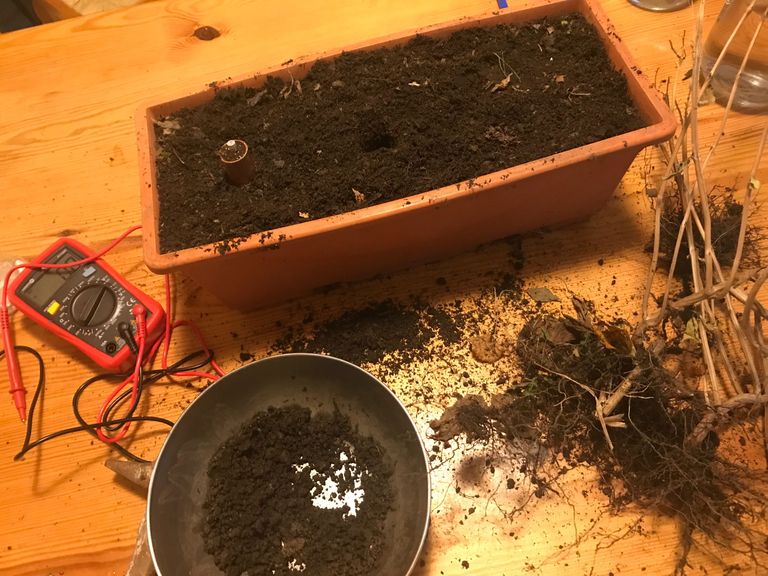
I made the same comparison between aluminium & zinc plated steel and again the zinc performed better.
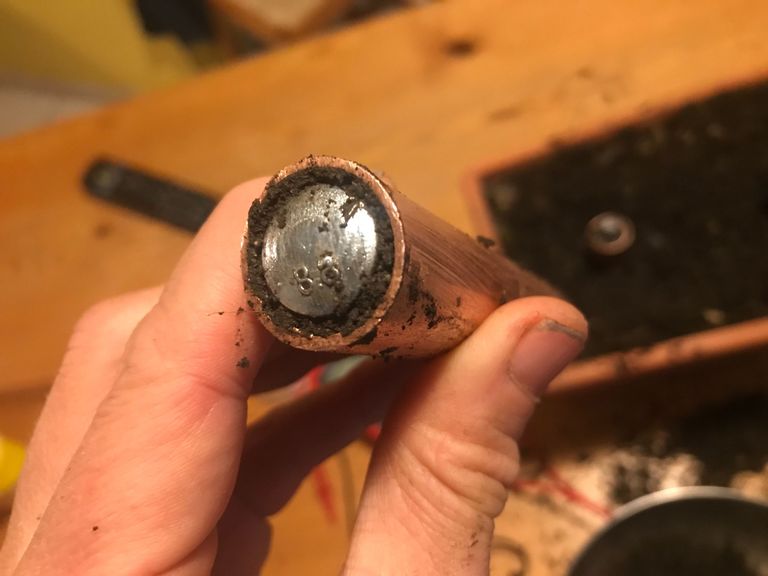
Giving me the same reading of 0.9v.
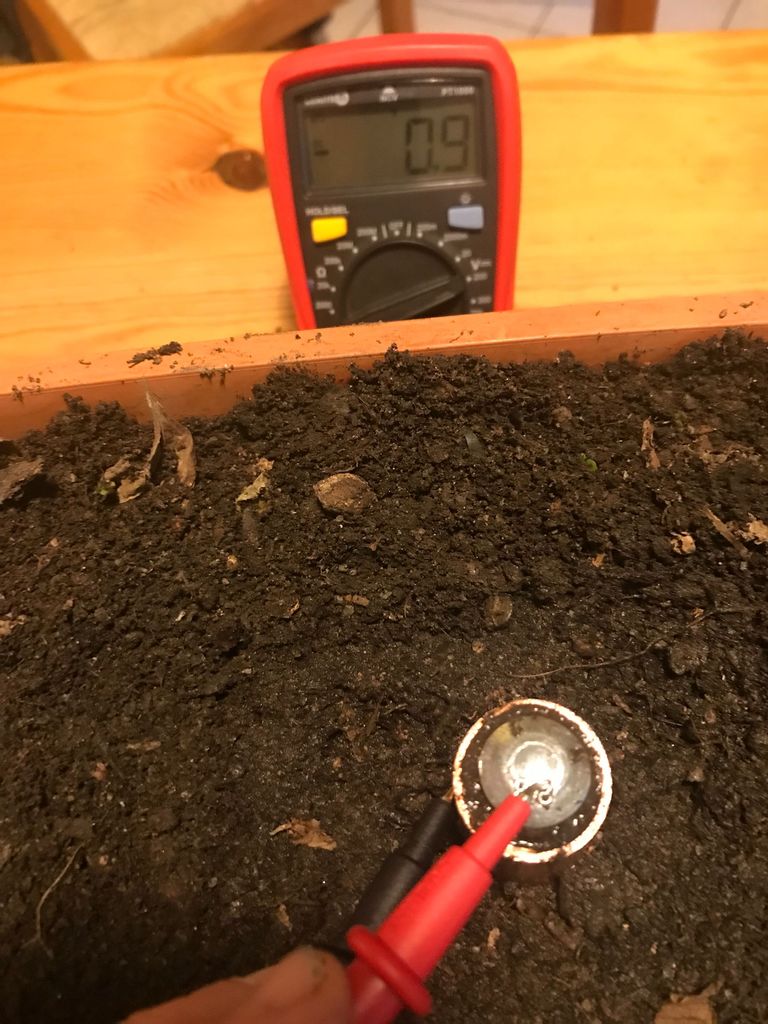
At this point I was joined by Santa's little helper who was keen to see the Peppa Pig working!
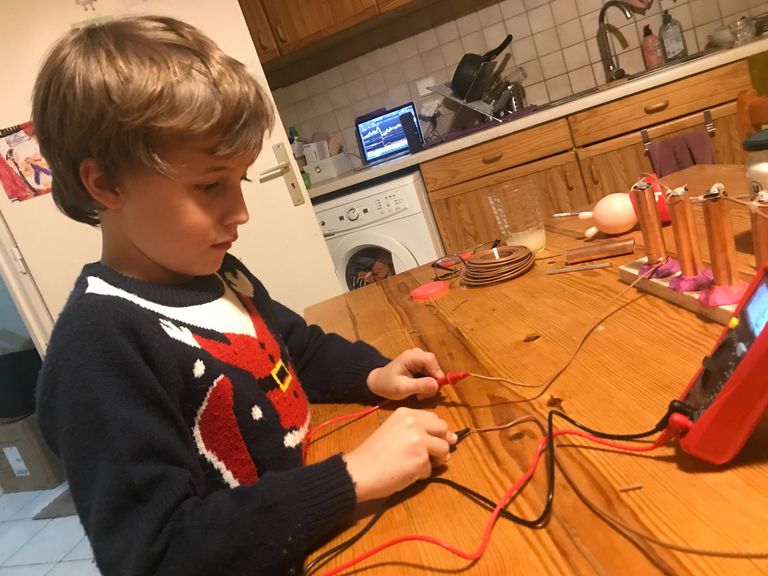
Here you can see we are getting a respectable 3.2v from four of our earth filled cells, which is 0.8v per cell and a little closer to their actual output of 0.9v per cell. Still losing energy somewhere though.
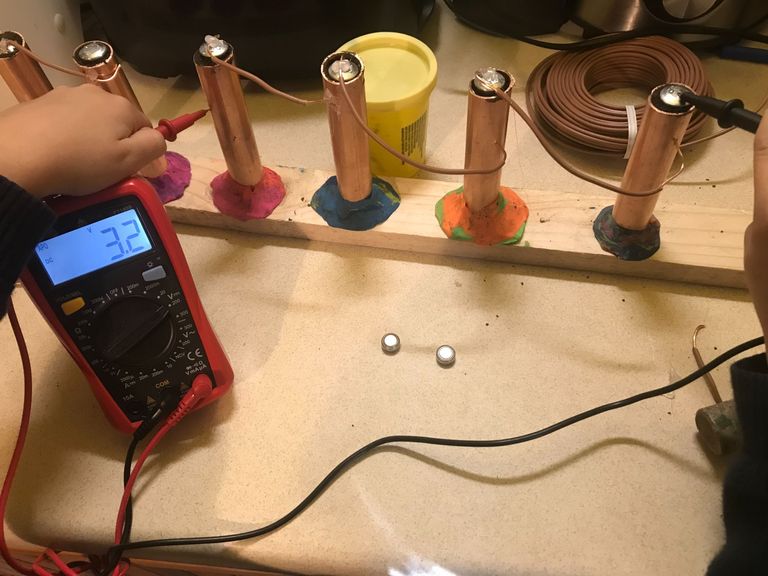
I put those two Peppa Pig batteries in the above shot to demonstrate the power I am producing here. Each one of those batteries is 1.5v and so, with my four earth battery cells I am producing more output than these two batteries. The difference of course is that my earth batteries can be made at home and they don't run out!
In the end it took a total of nine cells (some of which were using the less effective aluminium because I ran out of zinc plated bolts) to produce our desired output.
Here is the money shot in which we are producing a total of 5.2 volts!
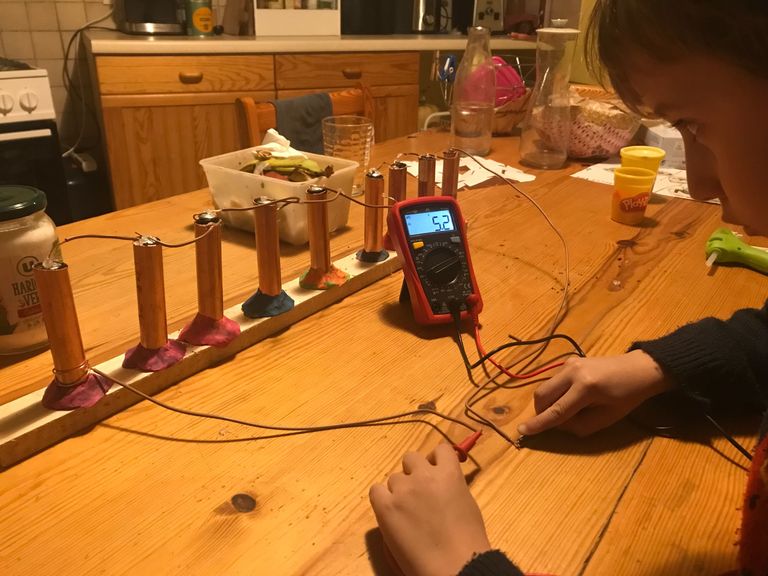
And that my friends is enough to power our 4.5v Peppa Pig.
When I touched those two cables onto the positive & negative elements of the Peppa Pig battery area, the light came on!
Unfortunately this light is designed to be very low and without the sufficient amperage it was even lower than normal and my camera was not able to pick it up. I realise now I should have chosen something brighter for this first test, like a collection of LEDs or perhaps something with movement, like a small motor?
So you are just going to have to trust me for now when I tell you that it worked! Sabrina & Esteban both witnessed it and that's good enough for me.
My next goal is to improve these connections. Just need to go buy some solder really. I also considered using little crocodile clips for these experiments but they didn't sell them at the local hardware store. Have ordered online.
Conclusion
I feel like I am making history here yet what I am doing is so very basic and can only imagine how many people before me must have reached these same conclusions based on these same experiments. (Any amount of voltage or amperage can be achieved with earth batteries).
What I am not understanding is how this has been kept a secret? Am I to expect now the men in black to turn up and shoot me with their heart attack gun? My body is in top shape by the way so if I do suddenly keel over you will know why! But jokes aside, why can't I find any evidence of people running their homes or their businesses in this manner?
It should I hope be obvious to you by now that if I can produce over 5v on my kitchen table in a few hours with a set-up which resembles a child's toy, a company with money behind it could quickly be producing a whole bunch more.
You may perhaps be wondering how one increases their amperage with a configuration of earth batteries?
Let's assume I have been able to create 1v cells and the amp reading on each of these cells is 0.8A (not much different to my actual readings). Let's also assume I am using metal solder in place of a glue gun, so all my connections are 100% conductive.
I then wire three sets of 12v in parallel, as shown here.
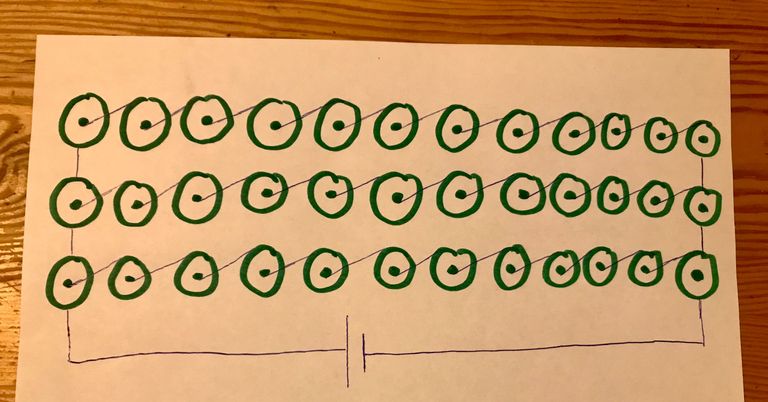
The final output will still be 12v but the amperage will increase by three times, giving me a total of 2.4A.
I don't know much about these things so I asked google how long it takes to charge a 12v car battery with a current of around 2 amps:
A 2 amp battery charger takes about 12 – 30 hours to fully charge a 12V car battery, depending on the battery’s capacity, depth of discharge, and battery temperature. source
And so, the earth battery configuration seen above should charge a standard car battery in under a day. But increasing the number of rows will increase your amps and therefore decrease your charging time. 30A they say will charge a 12v car battery in just over 3h.
Perhaps, as I am new to this subject, there is something I am misunderstanding here, but to me it seems clear & pretty damn amazing! And way better than solar not only because earth batteries last forever and you can build them at home, but also because you can charge your battery at night while you sleep.
And why have one battery when you can have a bank of batteries from which you can power every single application in your home (once you introduce an inverter to turn the DC to AC).
So, guess what my next investment is?
That's right. Car battery & inverter.
Free energy is real my friends and I hope this post has served as a decent Christmas present to you all!
Now get out there and set this up for yourselves so that you may never again pay for electricity at a time when it is only going to get more and more expensive.
Love & Light everyone 💡

Well done~! Happy Holidays. 🖖
Thanks! That was super fun and I am looking forward to a few bits arriving from the internet now so I can continue. Once these 10cm copper tubes are spray painted in a particular way (with red lacquer paint) and placed in the earth (running from north to south to tap into the magnetism) I am 100% certain that my voltage output per cell will increase.
It also reminded me of Bloom Energy, which was one of the first companies to take this concept to the next level (Fuel Cell) and has done the best work in the commercial sector since the mid 2000's... https://www.bloomenergy.com/technology/
Amazing! I don't understand however what is the difference between a fuel cell and a regular battery? It seems to me we are always talking about an exchange of electrons between a cathode and an anode, through a conductive medium.
I think Bloom use hydrogen in order to amplify the efficiency of the design to maximize current output, but it would probably still work without it, but not as powerful I believe.
Awesome. A modern day Tesla. I need to try some of these experiments here in Canada 🇨🇦 in the snow … ❄️ ❄️ ❄️
I played around with this stuff when I was a teenager around 35 year's ago now. Your maths is incorrect as you connect the cells in series to increase the voltage the amperes stay the same. So you have 12 cells in series to reach 12 volts but the amperes will still be 0.8 this gives 12v x0.8a = 9.6 watts of power. Joining the 3 strings of 12 cells will give you 2.4a at 12v. Far less then your calculation of 28 amps.
As I pointed out in my post I am still new to all this so I particularly appreciate your input. That calculation you just did there for example I had no idea about. So, we multiply voltage by amps to get watts. Good to know!
In one of the patents I read from 100 years ago it was stated that the load current increased by connecting earth cells in parallel, so I assumed this is what they meant but I see now how it works by your maths. The one reading I forgot to take during the experiment was the load current in series! I just assumed it would work the same way as the voltage. Incorrectly.
Thank you very much for this! I genuinely rely on people like yourself to guide me in these moments.
Will adjust the post accordingly.
Most welcome I'm glad I was able to help you with explaining the way it works. It can certainly be confusing when starting out.
"I feel like I am making history here"
Well then I guess I made history 30 years ago when I took Physics 11, along with several million other students that year. And for decades prior, and since. It's always nice to learn something yourself, from scratch, but you can't call it making history if it has been done the same way for generations.
By the way, this is not an "earth battery". You did not get better results when using wet soil than when using plain water. The common name for this is a simple electrochemical cell. Adding soil just makes your experiment dirty.
Not to ruin your fun, though! Carry on!
Hey buddy! Long time no see. Everything okay with you? I think I was pretty clear with my statement that I "felt" like I was making history which is quite obviously not the same as actually making history! Feelings can drive us forward or backward. And we get to choose whichever feelings we want ;)
I am confused however. If people are taught this at school why are they not now running their homes & businesses using free energy? I mean really, why would you spend one further moment paying over-priced electricity bills if you understood how to get electricity for free?
I don't get it. Perhaps you can help me find clarity here?
It's always nice to learn something yourself, from scratch! And then, it's sometimes useful to know the real history of that discovery, and what it ended up being called, so you can learn even more. I've had dozens of independent discoveries like this, and it's one of the best ways to learn. In fact, I often prefer it.
As for your question, why don't you go ahead and wire up your home and/or business with this free energy? Then you can discover the answer yourself, the best way. Once you get a refill on your solder, of course.
Happy discovering!
I find your answer leaving me unsatisfied.
If, as you say, millions of people know this info already, millions of people will have tried already what I am going to try. And you only have to look around you to see they did not succeed. So, what gives? I have already seen that voltage & amps can be increased indefinitely using these 'cells' (or whatever you want to call them) and from here we only need maths to calculate what we can do with our constant stream of free energy. Am grateful to @j85063 for helping me find the right maths of course, but now that I have understood this fully, I don't get what is the block between here and a bank of batteries which gets charged over-night to power a home?
You mentioned dozens of independent discoveries and I am wondering if you ever tried this particular experiment yourself?
Like I said, I did it in Physics 11, which for me was in 1990, along with millions of other students. It's required of anyone who takes physics, chemistry, and most general science courses. Your specific setup is called a galvanic cell, and I'm surprised your wife (who you say is educated/trained in this subject) could not fill you in, if you don't want to discover the answer to your own question yourself.
Unfortunately Sabrina's training has been largely forgotten. She didn't even believe this would work when I told her what I was doing! Hence my having to pick up her old educational books which were all in French so even harder for me to understand.
I checked your link and I see a whole bunch of reading and potentially further research just to understand what I am reading. It's like another language to someone who knows nothing about this! But I don't see any mention of using the earth between the cathode and anode in there?
I was hoping, if you knew the reason why this isn't going to work, that you might share it with me prior to the buying of a car battery and inverter? This little adventure has already cost me a fair bit (copper isn't cheap).
I rely on the experience of people like yourself & @j85063 at times like this and it doesn't seem in line with your character to let me go ahead with something knowing I am doomed to fail, without alerting me to what the stumbling block might be.
The answer is: it doesn't really last forever. The diodes are used up in the chemical reaction. You've created a rudimentary battery, just like a Duracell, which converts chemical energy into electric energy. It wears out and is not rechargeable. This information is available with a quick look on any search engine, but I guess you would rather read it from a fellow blogger. There are thousands of YouTube videos about it.
I'm not withholding information from you! If you're looking for further experiments to try, consider using distilled (100% pure) water instead of tapwater (or dirt). Also try adding table salt to your water. Also try baking soda or vinegar (to change the pH of the conductive solution).
Nothing wrong with trying to recharge a car battery this way. That's something I haven't done and would be interested in the results. Being able to solve a dead battery on the side of the road, with nothing but some water, wires, and pieces of 2 different kinds of metal, even if it's not "infinite", would be cool.
Absolutely! I can prove anything I like with a "quick look on any search engine". So your experience is always preferable.
Thank you for enlightening me. I feel much better now knowing the potential problem at the outset. Though I am confused a little by your words "used up" and keen now to see how a zinc plated bolt can be used up when placed in the soil inside a copper pipe? In time the answer will become apparent I suppose!
Hey, I think you will find my current post on electroculture interesting and potentially helpful in your garden. Would be interested to get your thoughts on that topic too!
Thanks again for the pointer here.
This is so much fun to see. I too never understood the whole amps and watts thing at school, still don't. When you work out what it all means can you explain it simply please. 😘
Congratulations, your post has been upvoted by @r2cornell, which is the curating account for @R2cornell's Discord Community.